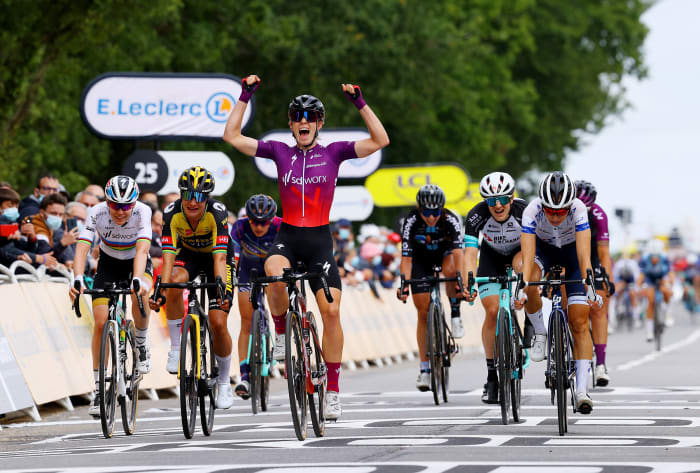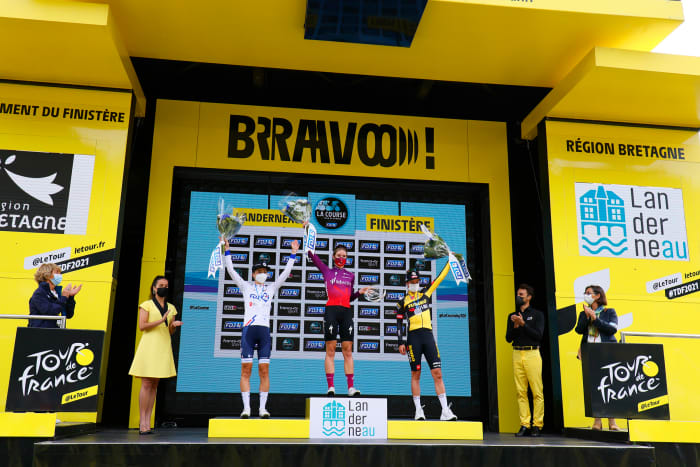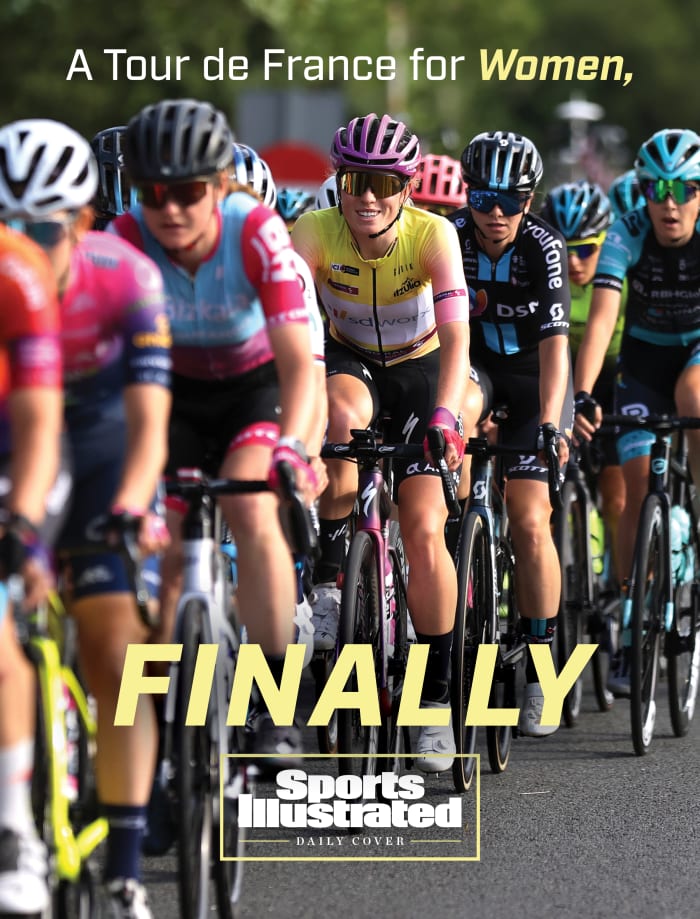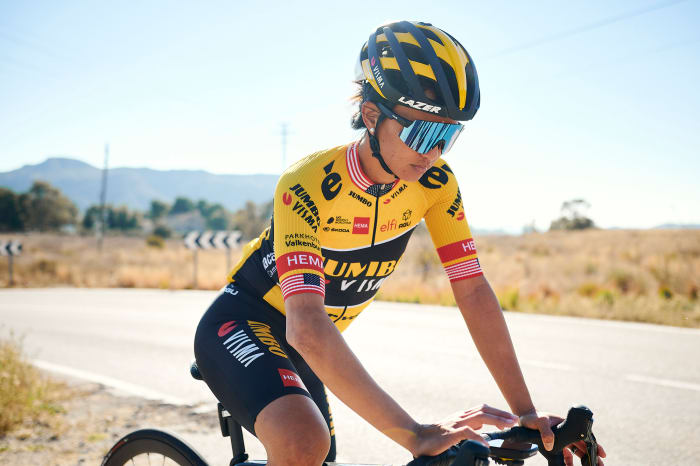Coryn Labecki credits childhood summer nights staying up late in California watching the Tour de France on television with teaching her how to race.
“I’d watch the climbers and then the sprinters, and then the windier days, and the breakaway days … and I think that’s where I actually learned a lot about what a long stage race would be like.”
Now a professional rider for Dutch team Jumbo-Visma, Labecki was like many Americans in that way. Though countless cycling road races go on each year, most receive only a fraction of the attention and recognition of the Tour de France, which is well known worldwide. But Labecki only ever saw men as part of that prestigious peloton, because for most of the last 120 years, there were only men riding the Tour de France.
But this year will be different. On July 24, Labecki and her team will be a part of the inaugural Tour de France Femmes avec Zwift—an 8-day stage competition that kicks off in Paris, marking the first time in 33 years there will be an official women’s Tour de France stage race. After years of controversy and stalling about a women’s Tour from the Amaury Sport Organisation (ASO), which organizes the Tour de France, this year’s men’s race will pass a baton of sorts. The day the men’s peloton will ride to the finish line along the Champs-Élysées, the women’s peloton will begin their race on the same road. The women will ride 1,033.6 km total (about 642.2 miles) over the eight diverse stages, ending on the climb to La Planche des Belles Filles on July 31. The prize purse is the highest in all of women’s cycling (€250,000 or about $256,108), the race will be broadcast in 170 countries and Zwift, the cycling video game platform, is on board as a title sponsor.
But the grueling test of endurance riders will need to complete this race will be nothing compared to how long it took to get here—or rather, back to here, with a women’s stage race as part of the pinnacle of professional road cycling.
A long, male-dominated history
The Tour de France began in 1903 as a gritty stage race put on by L’Equipe, a French newspaper, in order to inspire the people of France to spend money on bicycles. Historians say that the creators of the race carefully crafted the images of the male riders in the media to highlight their toughness and masculinity, so those following would want to be just like them—and buy and ride bikes of their own. According to Shelley Lucas, a sports historian and professor at Boise State University, competitive cycling’s roots in Europe have been intrinsically tied up with its own version of hypermasculinity, in a way comparable to football in the U.S. And that’s meant that even though women have been riding bicycles just as long as men, getting them opportunities to race—especially in long stage races and marquee cycle events like the Tour—has been more difficult than climbing even the steepest mountain stage.
“The governing bodies of cycling … have historically, and continue to be, run by men, who still today have preconceived notions about women’s physicality and what their bodies can and should do,” says Lucas.
Needless to say, a women’s version of a race defined by masculinity has faced some challenges. There have been women’s Tour de France races before—but they’ve been inconsistent, underfunded and “always felt like a bit of a sideshow,” according to Kate Veronneau, a former professional cyclist and director of women’s strategy at Zwift, the main sponsor for this year’s Tour de Femmes.
In the fall of 1955, for instance, a five-day stage race through Normandy, deemed the Tour de France Féminin, attracted 48 women riders from around Europe. But the media and spectators treated the cyclists as more of a publicity stunt than as true athletes. L’Equipe (still a part of the same company that organizes the Tour de France) would argue that, despite the fact nearly every rider (41) completed the race, women “should settle for cyclo-tourism, more appropriate to their muscular abilities.” Needless to say, the race didn’t continue after that year.
But in 1984, the first year women’s road racing was included in the Olympics, one of ASO’s race coordinators, Félix Lévitan, would add a women’s race yet again. The Tour de France Féminin riders rode (much shorter) portions of 18 of 23 stages in the men’s race, riding through the towns before the men would arrive. The problem was that hardly anyone knew they were coming. Though the crowds of spectators “were amazing,” according to Marianne Martin, the American who won the women’s race that year, media coverage was scant.
“I’ve had more press now than after I won,” Martin says. In fact, back in 2016, Martin told me that even when she crossed the finish line in victory, a journalist present told her he didn’t even know there were women racing the Tour. Those that did know, Martin recalls, “they didn’t think we would finish.”
And they weren’t the only ones—the women’s race covered just 1,080 km of the 4,000 km the men rode because of strict rules by the governing body for international bike racing, the Union Cycliste International (UCI), which limit the length of women’s races to be shorter than men’s. In fact, UCI had to grant the Tour de France Féminin an exemption for the race in the 1980s, because it violated UCI rules about rest time, though the women were given five rest days over the 23-day race, as opposed to one for the men.
ASO put on the Tour de France Féminin for five more years, until 1989. After deciding not to stage it in ’90, the group refused to allow naming rights to other women’s stage races in France. “They held on very dearly to their own naming rights,” says Kathryn Bertine, a former professional cyclist, and activist for gender equality in sport. So while La Grande Boucle Féminine ran as a women’s stage race off and on from ’92 to 2009, it never took on the same prestige, nor investment, as a Tour de France. “ASO could have played a very important and gracious role by letting other race directors use the name Tour de France Féminin, but they did not. And I definitely put that in the category of sexism and/or apathy,” Bertine says.

La Course By Le Tour was a one-day women’s race that took place last summer along the Champs-Élysées on the final day of the men’s Tour.
Tim de Waele/Getty Images
Scroll to Continue
SI Recommends
Le Tour Entier
In 2009, Bertine was an aspiring professional cyclist and sports journalist, who couldn’t figure out why there was no Tour de France Féminin anymore. She came up with a business plan of her own for how to incorporate a women’s race into the Tour and independently reached out to ASO about it. She didn’t hear back.
By 2012, as a professional cyclist, she began work on a documentary, Half the Road: The Passion, Pitfalls & Power of Women’s Professional Cycling. As she interviewed some of the biggest names in women’s professional cycling she realized she wasn’t alone—nearly everyone in women’s cycling was itching for a women’s Tour.
She banded together with Dutch cyclist Marianne Vos, English cyclist Emma Pooley and triathlete Chrissie Wellington, to form the group Le Tour Entier (“the whole tour”), which petitioned the ASO to take them up on the offer to help get a women’s Tour de France back off the ground. They garnered nearly 100,000 signatures on their 2013 online petition. By October the group had met with ASO and had a promise that a women’s race would be included in the ’14 Tour.
La Course by Le Tour de France, a one-day women’s race, took place that summer along the Champs-Élysées on the final day of the men’s Tour. Bertine was proud of the efforts of Le Tour Entier in getting a women’s race back under the Tour de France name, but hoped it was just the beginning. “We said one day is fine for the first year, if that’s what you need to feel secure, however, it’s imperative that you will stick to the promise of creating growth,” Bertine says.
She says the group suggested adding three to five days to La Course by Le Tour de France each year until it grew to be in line with the men’s 21-day race. “But for eight years [ASO] failed that promise,” Bertine says. Though La Course has changed venues from time to time, it has remained, in essence, a one-day race. (The 2017 race was technically held over two days, but only the first day’s competitive results were considered official.)
Over the years, ASO organizers have said that La Course was not being expanded into a full stage race because a Tour de France for women at the same time as the men’s Tour “would be logistically impossible.” Later, in 2021, after the announcement of the Tour de Femmes, Christian Prudhomme, director of the Tour de France, told The Guardian that ASO wanted to “create a race that will stay the course, that will be set up and stand the test of time. What that means is that the race cannot lose money.” He also said that: “Today, all the women’s races that we organise lose us money.” The ASO did not respond to Sports Illustrated requests for comment.
Enter: Zwift
When the Tour de France seemed threatened altogether by the COVID-19 pandemic in 2020, Zwift, an app which allows you to hook up your bike to a trainer and ride as an avatar through a virtual world, approached ASO about putting on a virtual race. ASO invited all of the world tour teams (men’s and women’s) to race on Zwift for a 5-day virtual event, and at Zwift’s insistence, the broadcast coverage rotated, so that one day the men’s peloton would race first, and the next day the women would start. The prize money and distances were all equal, and Zwift noticed that their viewership didn’t change whether the men or women were racing.
“If anything, the women’s racing was better,” says Veronneau. “The shorter format on Zwift really suited them. They really took advantage of the opportunity to showcase their strength, and it was incredibly exciting.”
That equity in the virtual race paved the way for a conversation with ASO about sponsoring a real women’s Tour de France stage race, according to Veronneau. “Our long history of advocating for more women’s opportunity in cycling and creating more pathways was just a natural fit,” she says. “It’s kind of funny when you think of this historic institution, ASO, and then Zwift, this modern video game company coming together, but that’s what it took to finally launch a multistage modern day Tour de France Femmes.”
A new chapter
And the partnership launching the race is coming at the right time for women’s cycling. Whereas women’s cycling over the past several decades has been defined more by passion and grit than paychecks and professionalism, a shift has taken place just in the last two years.
Lily Williams, a 28-year-old American, only discovered bike racing in 2016. She’d been a college track athlete and started working in a bike shop in Chicago during graduate school. She won her first professional race in ’17 and turned pro the following year. In ’20, when she joined U.S. road racing team Human Powered Health, she says women’s cycling, even at the professional level, had a DIY sheen. “People were coming to races in minivans and had two uniforms and had to buy a lot of their own equipment,” she says.
But two years later, she says, it’s a whole new world. “All of a sudden, I’m making a full salary from the sport. And every team has a huge number of staff and vehicles, and I can finish my race and go into our own personal team camper and take a shower. The whole sport has just grown leaps and bounds.”
And though Williams didn’t even consider herself a cyclist when La Course first brought a women’s race back to the Tour de France, later this month, she’ll be riding in what many hope to be a brand-new chapter of women’s professional cycling—including the premier stage race in the world. “I feel like I’m mostly just a beneficiary of that because there have been people who have been racing at the level I’m at now for a decade or more, and they’ve done it … self-supported on bare-bones resources.”
The recent leveling up in the world of professional women’s cycling has the women’s peloton excited about the potential growth of the Tour de France Femmes, and of the sport in general. Veronica Ewers, a 27-year-old American, will be lining up in Paris with her team EF Education-TIBCO-SVB, despite joining the professional cycling ranks just last year. Ewers senses the growth that she’s a part of. “Because more women have a livable salary and are able to go 100% in on cycling and therefore training harder and more … the women’s peloton is so much stronger,” she says. Now, racers like Ewers and Williams are proof that talented athletes aren’t just finding their way to cycling, they’re making livings off of it, which will only expand the number of athletes, and increase the level of competition in the sport.

Marianne Vos of the Netherlands (far right on podium) took third place in the La Course by Le Tour in 2021 and will compete for Team Jumbo-Visma in this year’s Tour de France Femmes, with Labecki.
Thomas Samson/Pool/Getty Images
This isn’t the finish line
For her part, Bertine is thrilled the Tour de France Femmes avec Zwift will finally enact the promise of growth she was given in 2013. “I challenge anyone to cheer louder than I will be cheering, because I’m gonna win,” she says. At the same time, she says, she hopes there will be more equality to come: in race distances, prize money and media coverage.
Bertine, whose book Stand: A Memoir on Activism. A Manual for Progress., details the long journey to getting a women’s Tour, says she’s tired of the excuses made for inequality when it comes to investment, marketing and broadcasting of women’s cycling. Instead, she says, the race directors and media should “step up and play a direct role in the advancement of women’s sports,” by promoting, running and covering women’s races in the same manner as the men’s, and see how the finances and viewership numbers change.
And while many in the cycling world agree shorter races on the women’s side actually make for a more entertaining watch (more lead changes and less coasting), Bertine says that doesn’t mean the men’s and women’s races should be so vastly different forever. “If women are continuously given a shorter distance than men, then it denotes that women are not as capable as men,” she says. “Can you imagine if men ran the marathon and then women had to exit the course around mile 19?” She hopes in the future there’s opportunity for longer women’s stages and shorter men’s stages, but that will require more major change in cycling.
This year’s Tour de France Femmes, just like the women’s race in 1984, had to receive an exemption from UCI to be approved as a world tour race for women. That’s because the UCI still has stringent limits on the number of days women’s stage races can be and how long they can be: no more than six days long, and each stage no longer than 160 km. In comparison, UCI allows men’s stages to be as long as 240 km. (The governing body also says men’s grand tour races must be between 15 and 23 days long.) This year’s Tour de France Femmes avec Zwift got an exemption to the six-day rule, and one stage will run 175 km, a bit beyond the women’s limit, but every women’s stage is shorter than every men’s Tour stage.
All of which gives the impression women still just can’t do what the men can. Except they can. Since 2015, a group of French women known as Donnons des Elles au Vélo (Give the girls a bike) have ridden every stage of the Tour a day before the men’s race. In ’19, they invited international women cyclists to join them. Louise Vardeman, a 44-year-old amateur cyclist in London and events manager by day, helped organize the international riders into a team of their own: The Internationelles, 10 riders and four support staff joined the French group in their Tour and call for a women’s stage race. “So many people were interested in our story because they didn’t realize there wasn’t a women’s Tour de France,” Vardeman says. “They thought that maybe there was one, but they hadn’t seen it on TV, or that the men’s just got more coverage, but that there had to be a women’s one. Why wouldn’t there be a women’s one? And we were like, ‘Nope, there isn’t one. They’re not allowed to ride.’”
During the 2019 protest ride, and all the accompanying media coverage, an ASO official told Reuters that a committee was being formed to develop a women’s race that “would be to women’s cycling what the Tour de France is to men’s cycling.”
Vardeman says when the announcement finally came in 2021 announcing the Tour de France Femmes avec Zwift, she and the other protest riders “were delighted.” While it’s not the same as the men’s 21-day ride, she sees it as an exciting start. “It’s not everything. And it’s not going to be as prestigious as the men’s one yet, but I think it’s a really great start this year.”
Bertine, too, sees this year’s race as one big step forward for women’s cycling—and gives credit to the many women who have been pushing for more gender equality for years, in cycling and in other women’s sports. “Change doesn’t just happen,” she says. “People make change happen.”
For Labecki’s part, after eight years as a professional cyclist, she’s looking forward to riding a real stage race under the historic Tour de France name. But she sees the women’s version of the race she watched growing up as an independent opportunity for women cyclists to “write our own story.” She hopes the race running after the men’s will be a way to grow the women’s cycling audience as its own product. At the same time, she hopes the prestige and renown of the Tour de France will be enough to expand its reach. “I think it’s really cool now that I can do the women’s Tour de France and have an eight-day narrative to show people on TV what we can do,” Labecki says.
Maybe those eight days will be enough for more young future cyclists watching the coverage of the Tour de France Femmes on a late summer night, learning from Labecki not just how to race, but that she can dream of seeing herself in the most famous bike race in the world one day.
• For U.S. Rugby, the Time Is Now. Maybe.
• The Unbreakable Bond of Stefon and Trevon Diggs
• Who’s Still Got Milk?
• ‘Oh, You Look Like the Rock’: Finding Rocky’s Family
Bagikan Berita Ini

















0 Response to "Tour de France Femmes Is a Women’s Sports Triumph Long in the Making - Sports Illustrated"
Post a Comment